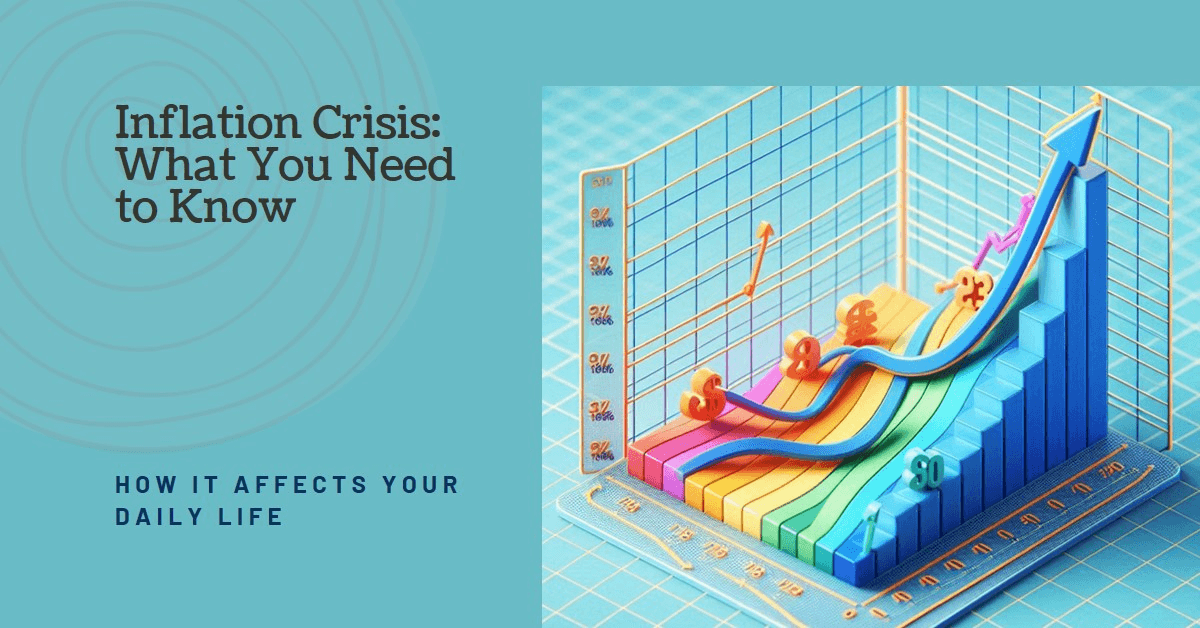In 2024, the global inflation crisis continues to take center stage as consumers around the world feel the impact on their wallets. From soaring food prices to rising energy costs, inflation is reshaping daily life for millions. While inflation is a natural part of economic cycles, the current crisis is driven by several key factors, including supply chain disruptions, geopolitical tensions, and a post-pandemic surge in demand. This article delves into how inflation is affecting global markets, particularly food and energy prices, and the measures governments are taking to curb rising costs.
What is Inflation and How Does It Affect Consumers?

Inflation refers to the rate at which the general level of prices for goods and services rises, leading to a decrease in purchasing power. When inflation occurs, consumers find that their money buys fewer goods than it did before. For everyday consumers, this means higher prices for essential items like groceries, gasoline, and household utilities.
The global inflation rate reached unprecedented levels in 2022 and 2023, with many countries experiencing inflation rates not seen in decades. For example, inflation in the U.S. peaked at 9.1% in 2022, the highest since 1981. In 2024, inflation remains a significant challenge in both developed and developing economies, with key sectors like food and energy being the hardest hit.
Rising Food Prices: A Pressing Concern for Households
One of the most visible effects of inflation has been on food prices. According to the Food and Agriculture Organization (FAO), global food prices surged by more than 20% between 2021 and 2023, pushing millions of households into financial stress. The factors driving this increase include:
- Supply Chain Disruptions: The COVID-19 pandemic, followed by geopolitical conflicts such as the Russia-Ukraine war, disrupted global supply chains, causing food shortages and price hikes. Russia and Ukraine are key suppliers of wheat, corn, and fertilizers, and the war has disrupted their export markets, leading to a surge in global food prices.
- Energy Costs: Rising energy costs have had a direct impact on food production and distribution. From farming machinery that relies on fuel to trucks that transport food to grocery stores, energy prices have a cascading effect on the cost of food.
- Climate Change: Extreme weather patterns, exacerbated by climate change, have reduced crop yields. In 2024, droughts, floods, and other natural disasters have further diminished agricultural output, putting pressure on food supplies.
For everyday consumers, the result is higher grocery bills and tighter budgets. Staples like wheat, rice, and cooking oil have seen dramatic price increases. In many developing countries, where food comprises a large portion of household spending, this has led to rising hunger and malnutrition rates.
For more in-depth analysis of the food crisis, check out this article on Food Security and Global Agriculture Trends.
Soaring Energy Costs: Impact on Daily Life
Another area where inflation is hitting consumers hard is energy. The global energy market has experienced significant volatility since 2021, with energy prices continuing to rise throughout 2024. Several factors contribute to this surge:
- Geopolitical Tensions: The ongoing conflict between Russia and Ukraine has not only disrupted food supplies but has also affected global oil and gas markets. Russia is one of the world’s largest exporters of energy, and sanctions have led to reduced energy exports, driving up prices.
- Supply and Demand Imbalance: As economies recover from the pandemic, demand for energy has increased rapidly, but supply has struggled to keep pace. This mismatch has driven energy costs higher, affecting everything from electricity bills to gasoline prices.
- Shift to Renewable Energy: While the transition to renewable energy is necessary for combating climate change, it has created short-term challenges. Investments in renewable energy infrastructure are high, and the cost of transitioning from fossil fuels to clean energy sources is being passed on to consumers.
For consumers, this translates into higher utility bills and transportation costs. Heating homes in winter, running air conditioners in summer, and filling up cars with gasoline have all become more expensive, adding further strain to household budgets.
To learn more about the future of renewable energy and its impact on energy costs, visit Emerging Trends in Renewable Energy.
How Governments are Tackling the Inflation Crisis
Governments around the world have implemented several strategies to control inflation and mitigate its impact on consumers. However, the effectiveness of these measures varies from country to country.
- Monetary Policy Adjustments: Central banks, including the U.S. Federal Reserve, the European Central Bank, and the Reserve Bank of India, have raised interest rates in an attempt to curb inflation. Higher interest rates make borrowing more expensive, which can reduce consumer spending and help bring inflation down.
- Subsidies and Price Controls: Some governments have introduced subsidies for essential goods, such as fuel and food, to ease the burden on households. For instance, several European countries implemented fuel price caps to protect consumers from skyrocketing energy costs during the winter months.
- Supply Chain Improvements: Governments and international organizations are working to address supply chain bottlenecks by improving infrastructure, encouraging domestic production, and reducing reliance on imports.
- Energy Diversification: Countries are diversifying their energy sources to reduce dependence on imported oil and gas. Investments in renewable energy, nuclear power, and energy storage technologies are part of long-term strategies to stabilize energy prices.
For a deeper dive into how inflation is affecting small businesses and what can be done to mitigate its effects, check out our piece on Inflation and Small Business Strategies.
The Future Outlook: Will Inflation Ease?
While governments and central banks are taking steps to control inflation, experts predict that it may take time before consumers see significant relief. The combination of ongoing geopolitical tensions, climate change, and the shift to renewable energy suggests that inflationary pressures will persist throughout 2024 and beyond.
However, as supply chains stabilize, energy markets adapt, and global economies adjust, there is hope that inflation will begin to moderate by the end of the year. Until then, consumers will need to navigate rising prices by budgeting carefully, reducing discretionary spending, and seeking ways to conserve energy.
For tips on how to manage your household budget during times of inflation, explore our guide on Financial Planning in 2024.
Conclusion
The global inflation crisis is reshaping the economic landscape, with food and energy prices at the forefront of consumer concerns. While governments and central banks are working to manage inflation, the impact on everyday consumers remains profound. From grocery bills to energy costs, inflation is making daily life more expensive, and the road to relief may still be long. By staying informed and making strategic financial decisions, consumers can weather the storm and prepare for a more stable economic future.
For more articles on economic trends and financial strategies, be sure to check out Epic Infinite.
External Links:
- Food and Agriculture Organization (FAO) Reports on Global Food Prices
- U.S. Federal Reserve Inflation Reports
- International Energy Agency (IEA) Insights on Energy Markets
Internal Links from Epic Infinite:










